A Study on the Mechanism of Fracture Initiation and Propagation under Multi-Perforation Conditions in Hydraulic Fracturing
Abstract
:1. Introduction
2. Mathematical Model and Experiment
2.1. Mathematical Model for Fracture Initiation and Propagation
2.2. Experiment of Multi-Perforation Fracturing
2.2.1. Multiple Perforation Fracturing Experimental Protocol
2.2.2. The Effect of Principal Stress Differences on Fracturing
2.2.3. Influence of Injection Flow Rate on Fracturing
2.2.4. Analysis of Multi-Perforation Initiation
3. Simulation under Multi-Perforation Conditions
3.1. Model Description
3.2. Verification of Extended Finite Element Model
3.3. Simulation Results and Analysis
3.3.1. The Influence of Perforation Spacing on Fracture Initiation and Propagation
3.3.2. The Influence of the Number of Perforations on Fracture Initiation and Propagation
3.3.3. The Influence of Different In Situ Stress Conditions on the Initiation and Propagation of Fractures
3.3.4. The Influence of Different Injection Flow Rates on the Initiation and Propagation of Fractures
4. Discussion
- (1)
- All perforations can initiate fractures under the condition of multiple perforations in one cluster when using experimental and simulation methods. The parallel fracture swarms discovered at the Hydraulic Fracturing Test Site (HFTS) are highly likely to be caused by the initiation and continuous propagation of each perforation. Due to the stress interference between perforations, the order of perforation initiation varies, but there is a trend of parallel propagation.
- (2)
- When the perforation spacing is 12 cm, the interference between fractures is significantly reduced compared to 6 cm. Thus, increasing the perforation spacing is beneficial for the parallel expansion of fractures toward the distal end.
- (3)
- With five perforations, the stress interference of initiation and propagation between the fractures is stronger. When the number of perforations is three, the initiation time of the perforations is earlier, and the mutual interference between fractures is weaker, which is more conducive to the parallel propagation of fractures. Reducing the number of perforations has a positive effect on the initiation and expansion of hydraulic fracturing.
- (4)
- When the principal stress difference is 10 MPa, fractures start earlier than when it is 5 MPa, and the initiation time of perforation is advanced by 2–3 s. The deflection angle of the outermost crack is almost 90° when the stress difference is 5 MPa. The greater the principal stress difference, the smaller the degree of stress interference in fracture propagation, and the fractures become more uniform during propagation, which is conducive to the formation of parallel propagation fractures. Moreover, the extension length is larger at the same time point, which supports the development of fractures toward the far end. In addition, the comparison showed that when the principal stress difference is larger, the initiation time of perforation is earlier, which is consistent with the experimental results.
- (5)
- Both the experimental and simulation results indicate that a higher flow rate is conducive to fracture initiation and propagation. An increase in the flow rate has a reduced impact on the shape of fractures, but it increases the propagation speed of fractures, and the crack length increases by about 80% at 600 s.
Author Contributions
Funding
Data Availability Statement
Conflicts of Interest
References
- Dong, D.; Wang, Y.; Li, X.; Zou, C.; Guan, Q.; Zhang, C.; Huang, J.; Wang, S.; Wang, H.; Liu, H.; et al. New breakthroughs and development prospects of shale gas exploration and development in China. Nat. Gas Ind. 2016, 18, 1–5. [Google Scholar]
- Zhang, J. Practice and Enlightenment of first principles in shale gas revolution. Drill. Eng. 2022, 49, 1–8. [Google Scholar]
- Zou, C.; Zhao, Q.; Cong, L. Progress, potential and Prospect of shale gas development in China. Nat. Gas Ind. 2021, 41, 1–14. [Google Scholar]
- Lei, L.; Zhang, L.; Xiong, W.; Xia, W. Staged fracturing technology for atmospheric shale gas horizontal wells in Wulong block. Pet. Drill. Tech. 2019, 47, 76–82. [Google Scholar]
- Wang, S. Analysis on staged fracturing technology for shale gas horizontal wells. Process Technol. 2021, 1, 184–186. [Google Scholar]
- Pei, Y.; Ma, S.; Li, L.; Xu, J. Research review of shale gas well fracturing technology. Petrochem. Technol. 2019, 26, 266–267. [Google Scholar]
- Spain, D.R.; Gil, I.; Sebastian, H.; Smith, P.S.; Wampler, J.; Cadwallader, S.; Graff, M. Geo-Engineered Completion Optimization: An Integrated, Multi-Disciplinary Approach to Improve Stimulation Efficiency in Unconventional Shale Reservoirs. In Proceedings of the SPE Middle East Unconventional Resources Conference and Exhibition, Muscat, Oman, 26–28 January 2015. [Google Scholar]
- Li, Y.; Deng, J.; Liu, W.; Yan, W.; Cao, W.; Wang, P. Numerical simulation of segmented multi cluster flow limiting fracturing in horizontal wells. Fault-Block Oil Gas Field 2017, 24, 69–73. [Google Scholar]
- Ciezobka, J.; Courtier, J.; Wicker, J.; Laredo Petroleum, Inc. Hydraulic Fracturing Test Site (HFTS)–Project Overview and Summary of Results. In Proceedings of the Unconventional Resources Technology Conference, Houston, TX, USA, 23–25 July 2018. [Google Scholar]
- Male, F.; Rysak, B.; Dommisse, R. Statistical Analysis of Fractures from the Hydraulic Fracture Test Site 1. In Proceedings of the Unconventional Resources Technology Conference, Houston, TX, USA, 26–28 July 2021. [Google Scholar]
- Bessa, F.; Jerath, K.; Ginn, C.; Johnston, P.; Zhao, Y.; Brown, T.; Lopez, R.; Kessler, J.; Nicklen, B.; Sahni, V. Subsurface Characterization of Hydraulic Fracture Test Site-2 (HFTS-2), Delaware Basin. In Proceedings of the Unconventional Resources Technology Conference, Houston, TX, USA, 26–28 July 2021. [Google Scholar]
- Ciezobka, J.; Reeves, S.; Gas Technology Institute (GTI). Overview of Hydraulic Fracturing Test Sites (HFTS) in the Permian Basin and Summary of Selected Results (HFTS-I in Midland and HFTS-II in Delaware). In Proceedings of the Latin America Unconventional Resources Technology Conference, Online, 16–18 November 2020. [Google Scholar]
- Cao, M.; Zheng, S.; Elliott, B.; Sharma, M. Impact of Complex Fracture Networks on Well Productivity: A Case Study of the Hydraulic Fracturing Test Site #2. In Proceedings of the SPE Hydraulic Fracturing Technology Conference and Exhibition, The Woodlands, TX, USA, 1–3 February 2022. [Google Scholar]
- Li, C.; Pang, Y.; Zhou, Y.; Zhan, J.; Zhu, S. Analysis on the conditions of producing volume pressure fracture network in formation. Fault-Block Oil Gas Field 2022, 29, 101–106. [Google Scholar]
- Raterman, K.T.; Farrell, H.E.; Mora, O.S.; Janssen, A.L.; Gomez, G.A.; Busetti, S.; McEwen, J.; Friehauf, K.; Rutherford, J.; Reid, R.; et al. Sampling a stimulated rock volume: An Eagle Ford Example. In Proceedings of the SPE Hydraulic Fracturing Technology Conference, The Woodlands, TX, USA, 24–26 January 2017. [Google Scholar]
- Sesetty, V.; Ghassemi, A. Simulation and Analysis of Fracture Swarms Observed in the Eagle Ford Field Experiment. In Proceedings of the SPE Hydraulic Fracturing Technology Conference and Exhibition, The Woodlands, TX, USA, 5–7 February 2019. [Google Scholar]
- Weijermars, R.; Pham, T.; Stegent, N.; Dusterhoft, R. Hydraulic Fracture Propagation Paths Modeled using Time-Stepped Linear Superposition Method (TLSM): Application to Fracture Treatment Stages with Interacting Hydraulic and Natural Fractures at the Wolfcamp Field Test Site (HFTS). In Proceedings of the 54th US Rock Mechanics/Geomechanics Symposium, Golden, CO, USA, 28 June–1 July 2020. [Google Scholar]
- Tan, P.; Pang, H.; Zhang, R.; Jin, Y.; Zhou, Y.; Kao, J.; Fan, M. Experimental investigation into hydraulic fracture geometry and proppant migration characteristics for southeastern Sichuan deep shale reservoirs. J. Pet. Sci. Eng. 2018, 184, 106517. [Google Scholar] [CrossRef]
- Zhang, Q.; Zhang, X.-P.; Sun, W. A review of laboratory studies and theoretical analysis for the interaction mode between induced hydraulic fractures and pre-existing fractures. J. Nat. Gas Sci. Eng. 2021, 86, 103719. [Google Scholar] [CrossRef]
- Guo, T.; Tang, S.; Liu, S.; Liu, X.; Xu, J.; Qi, N.; Rui, Z. Physical Simulation of Hydraulic Fracturing of Large-Sized Tight Sandstone Outcrops. SPE J. 2021, 26, 372–393. [Google Scholar] [CrossRef]
- Wei, C.; Zhang, B.; Li, S.; Fan, Z.; Li, C. Interaction between hydraulic fracture and pre-existing fracture under pulse hydraulic fracturing. SPE Prod. Oper. 2021, 36, 553–571. [Google Scholar] [CrossRef]
- Chi, Z.; Tong, Z.; Xiao, J.; Wei, Q.; Ma, W. Practice and understanding of infill well fracturing technology in Fuling shale gas field. Fault-Block Oil Gas Field 2022, 29, 775–779. [Google Scholar]
- Chen, J.; Xu, H. Numerical simulation of hydraulic fracturing based on ABAQUS. Inn. Mong. Petrochem. Ind. 2020, 2, 46–48. [Google Scholar]
- Duan, K.; Kwok, C.Y.; Zhang, Q.; Shang, J. On the initiation, propagation and reorientation of simultaneously-induced multiple hydraulic fractures. Comput. Geotech. 2020, 117, 103226. [Google Scholar] [CrossRef]
- Li, X.; Hofmann, H.; Yoshioka, K.; Luo, Y.; Liang, Y. Phase-Field Modelling of Interactions Between Hydraulic Fractures and Natural Fractures. Rock Mech. Rock Eng. 2022, 55, 6227–6247. [Google Scholar] [CrossRef]
- Dou, F.; Wang, J.G. A numerical investigation for the impacts of shale matrix heterogeneity on hydraulic fracturing with a two-dimensional particle assemblage simulation model. J. Nat. Gas Sci. Eng. 2022, 104, 104678. [Google Scholar] [CrossRef]
- Han, W.; Cui, Z.; Zhang, J. Fracture path interaction of two adjacent perforations subjected to different injection rate increments. Comput. Geotech. 2020, 122, 103500. [Google Scholar] [CrossRef]
- Zhang, J.G.; Li, X.P.; Wang, C.R.; Lu, A.; Sun, Z.X. Numerical simulation of rock formation stress-fluid pressure coupling and development of artificial fractures during hydraulic fracturing of shale gas reservoirs. J. China Univ. Pet. (Ed. Nat. Sci.) 2018, 42, 96–105. [Google Scholar]
- Salimzadeh, S.; Khalili, N. A three-phase XFEM model for hydraulic fracturing with cohesive fracture propagation. Comput. Geotech. 2015, 69, 82–92. [Google Scholar] [CrossRef]
- Irwin, G.R. Analysis of Stress and Strains Near the End of a fracture Traversing a Plate. J. Appl. Mech. 1957, 24, 361–364. [Google Scholar] [CrossRef]
- Guo, L.; Chen, Z.; Luo, J.; Chen, G. Overview of Extended Finite Element Methods and its applications. Chin. Q. Mech. 2011, 32, 612–625. [Google Scholar]
- Li, Q.; Wang, F.; Wang, Y.; Forson, K.; Cao, L.; Zhang, C.; Zhou, C.; Zhao, B.; Chen, J. Experimental investigation on the high-pressure sand suspension and adsorption capacity of guar gum fracturing fluid in low-permeability shale reservoirs: Factor analysis and mechanism disclosure. Environ. Sci. Pollut. Res. 2022, 29, 53050–53062. [Google Scholar] [CrossRef] [PubMed]
- Li, Q.; Han, Y.; Liu, X.; Ansari, U.; Cheng, Y.; Yan, C. Hydrate as a by-product in CO2 leakage during the long-term sub-seabed sequestration and its role in preventing further leakage. Environ. Sci. Pollut. Res. 2022, 29, 77737–77754. [Google Scholar] [CrossRef] [PubMed]
- Li, Y. The Optimization of Hydraulic Fracturing Construction Parameter Based on XFEM. Master’s Thesis, China University of Petroleum, Beijing, China, 2018. [Google Scholar]
- Chen, J.; Wei, B.; Xie, Q.; Wang, H.; Li, T. Multi fracture simulation of shale horizontal well based on extended finite element method. Appl. Math. Mech. 2016, 37, 73–83. [Google Scholar]
- Geersma, J.; Klerk, F.D. A rapid method of predicting width and extent of hydraulically induced fractures. J. Pet. Technol. 1969, 21, 1571–1581. [Google Scholar] [CrossRef]
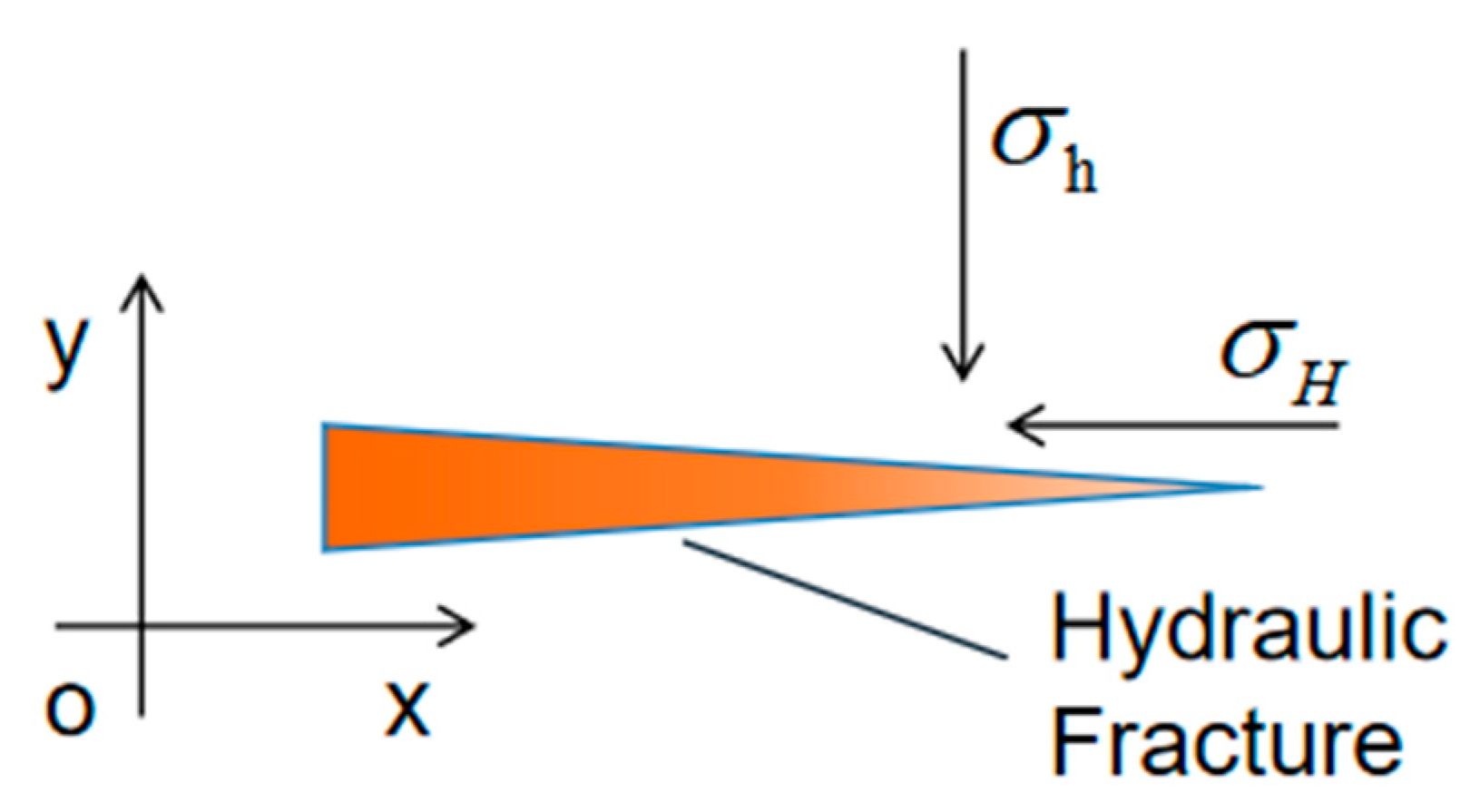
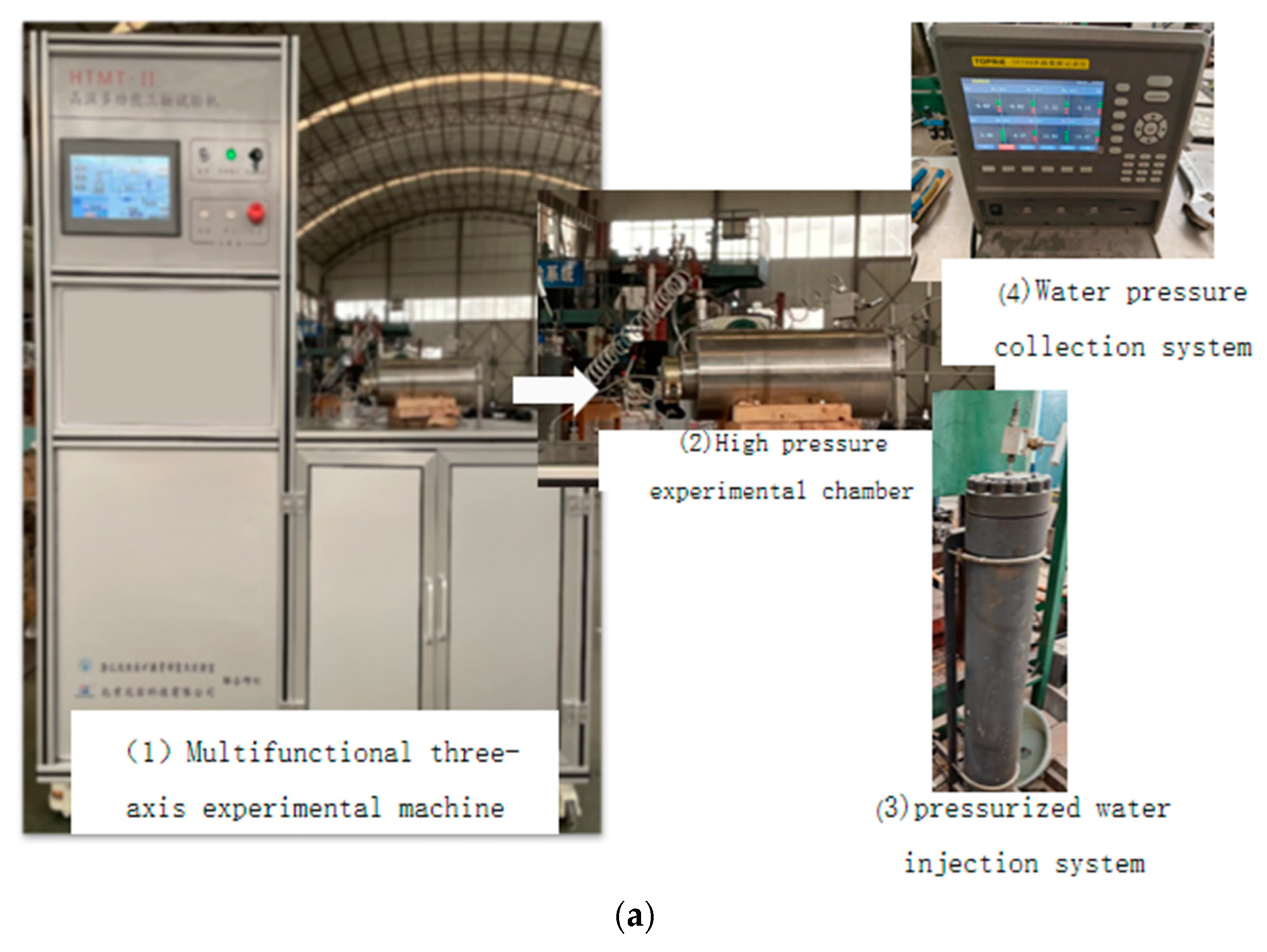

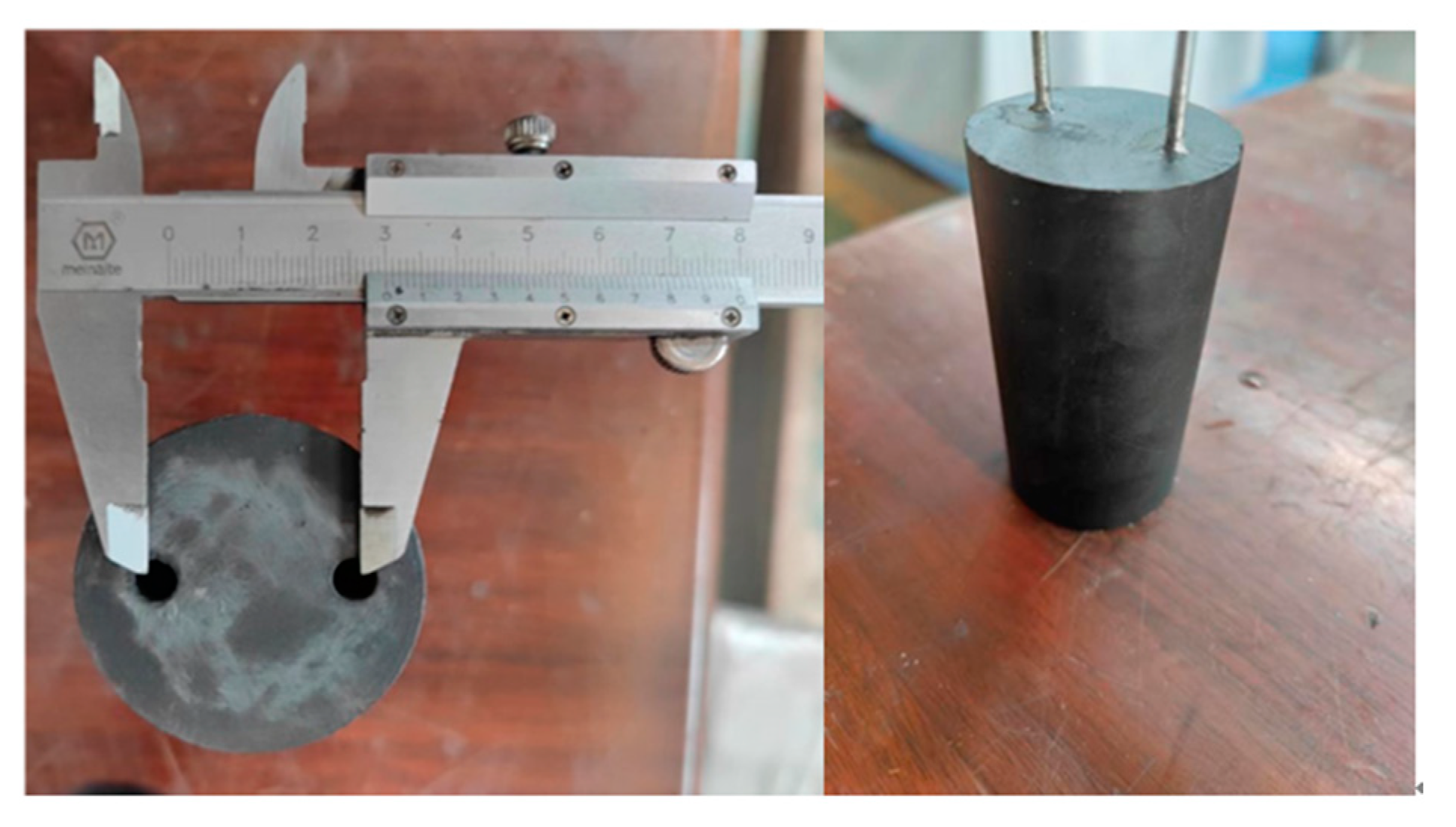





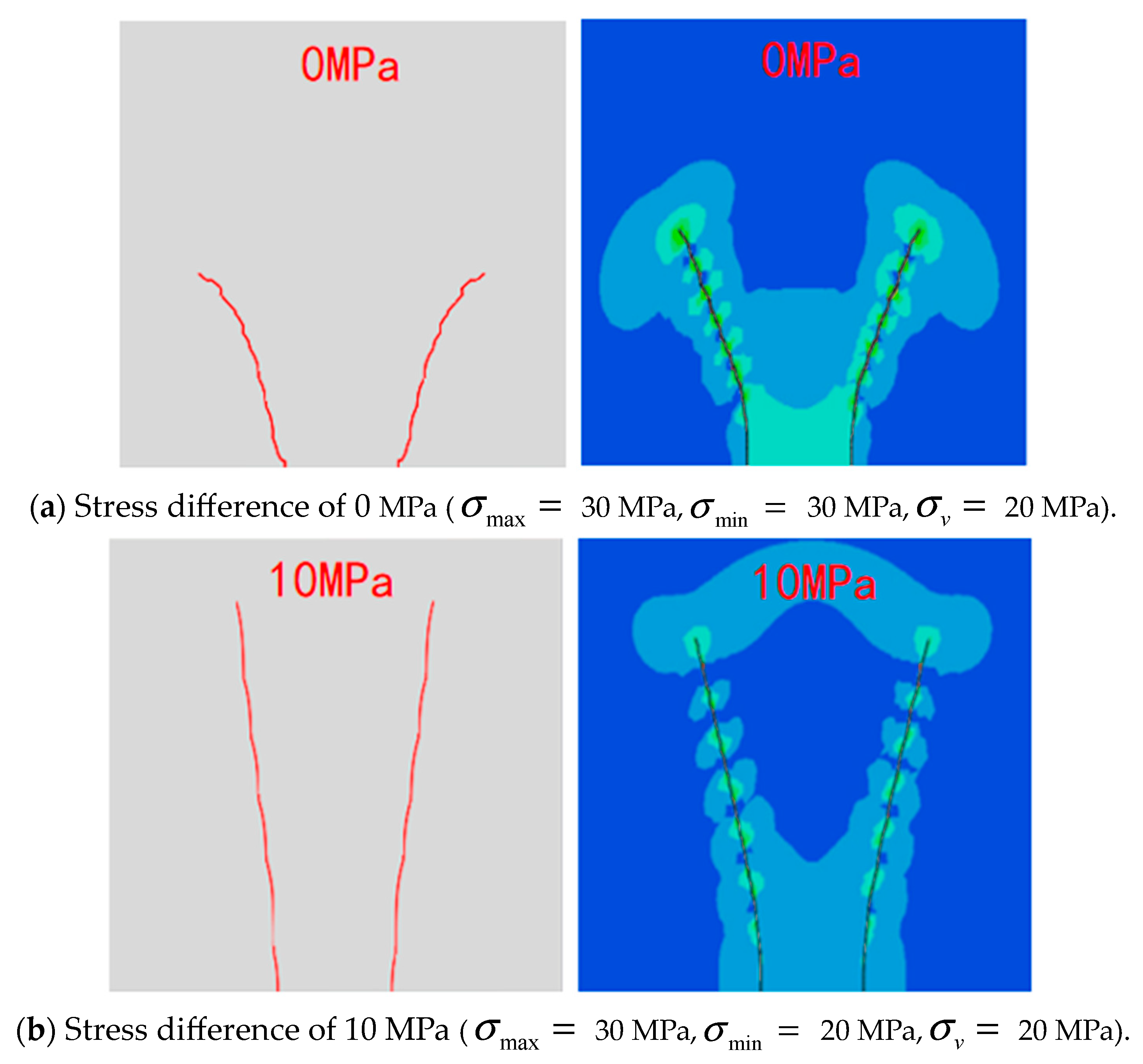

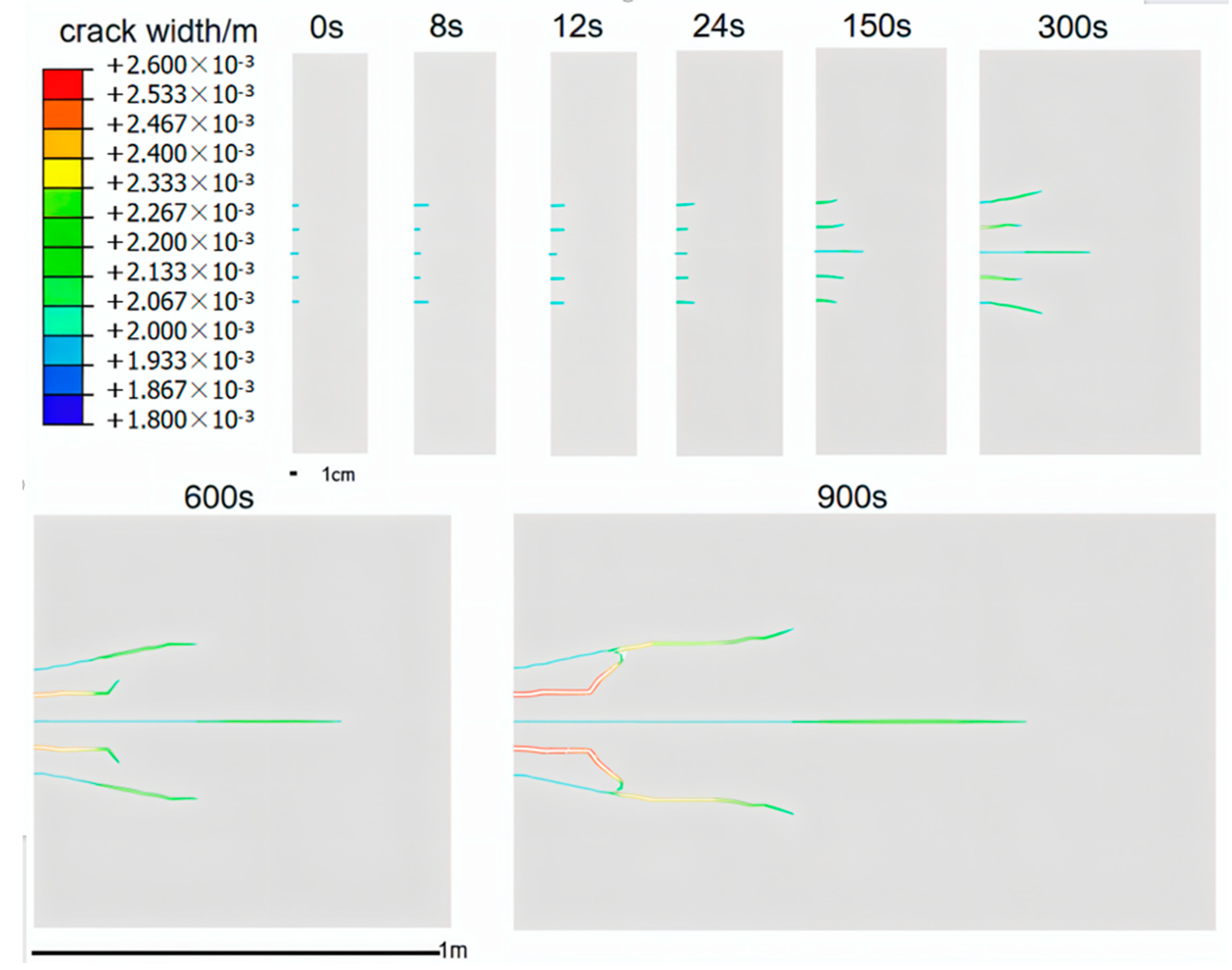
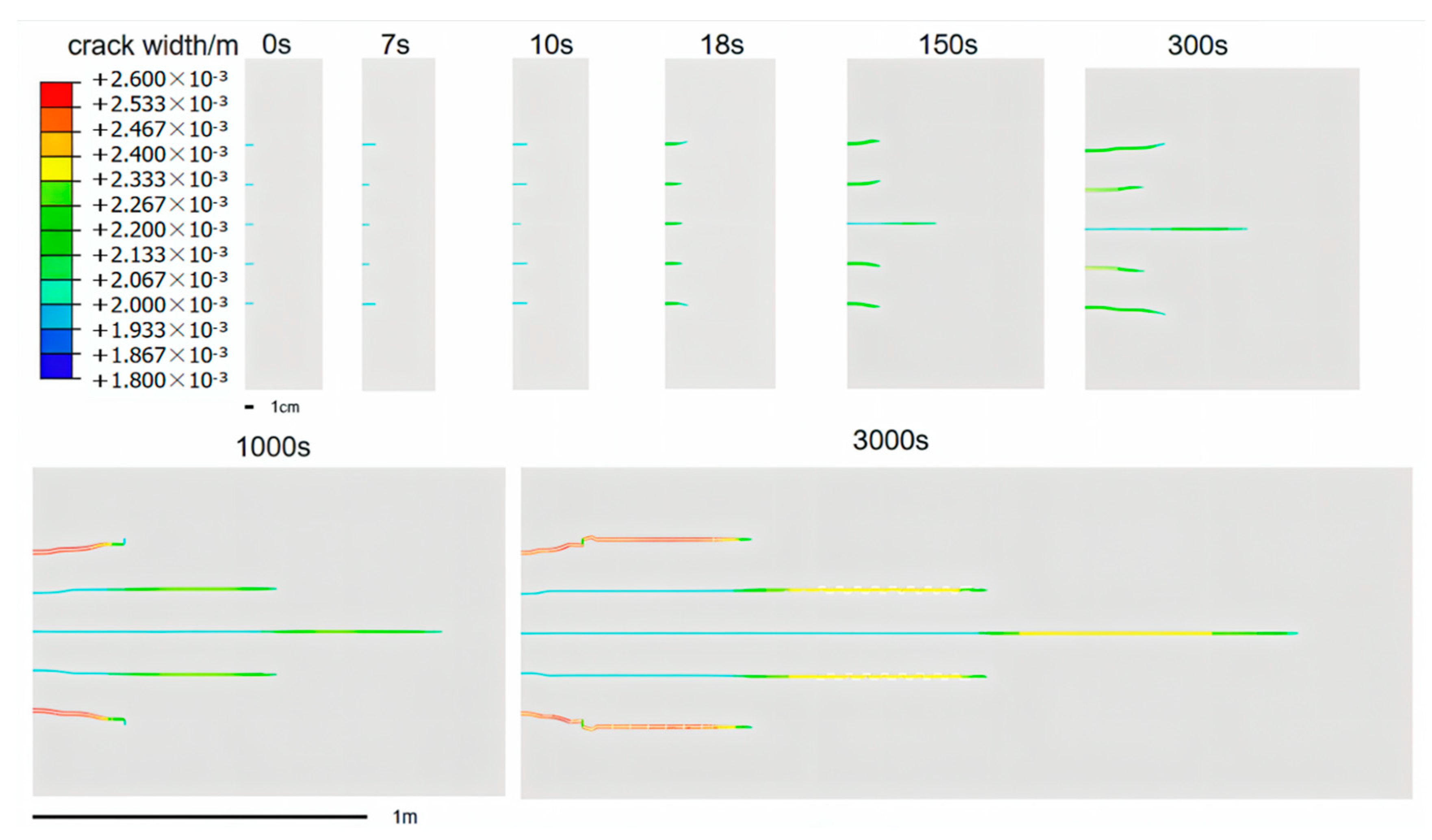

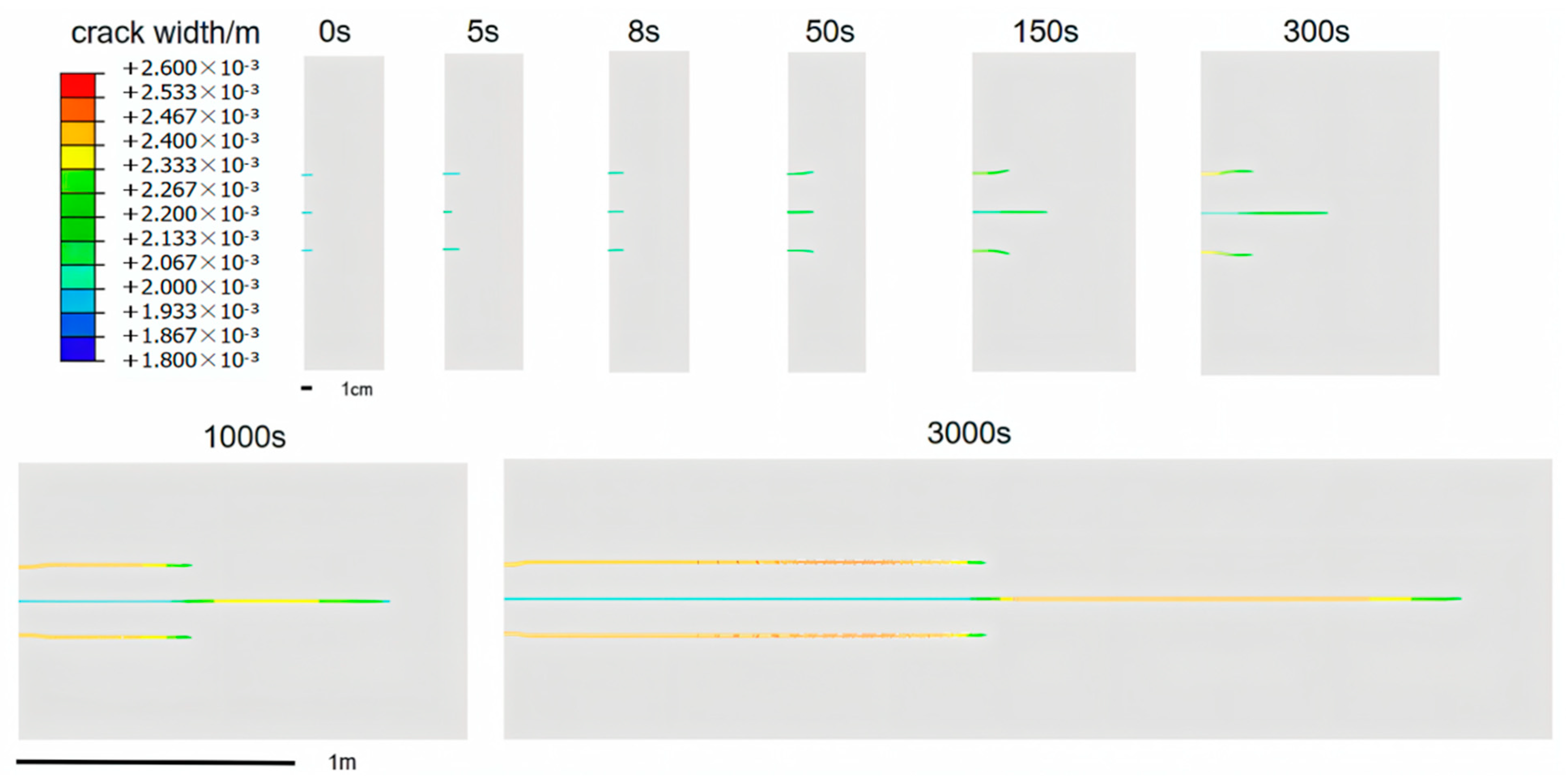


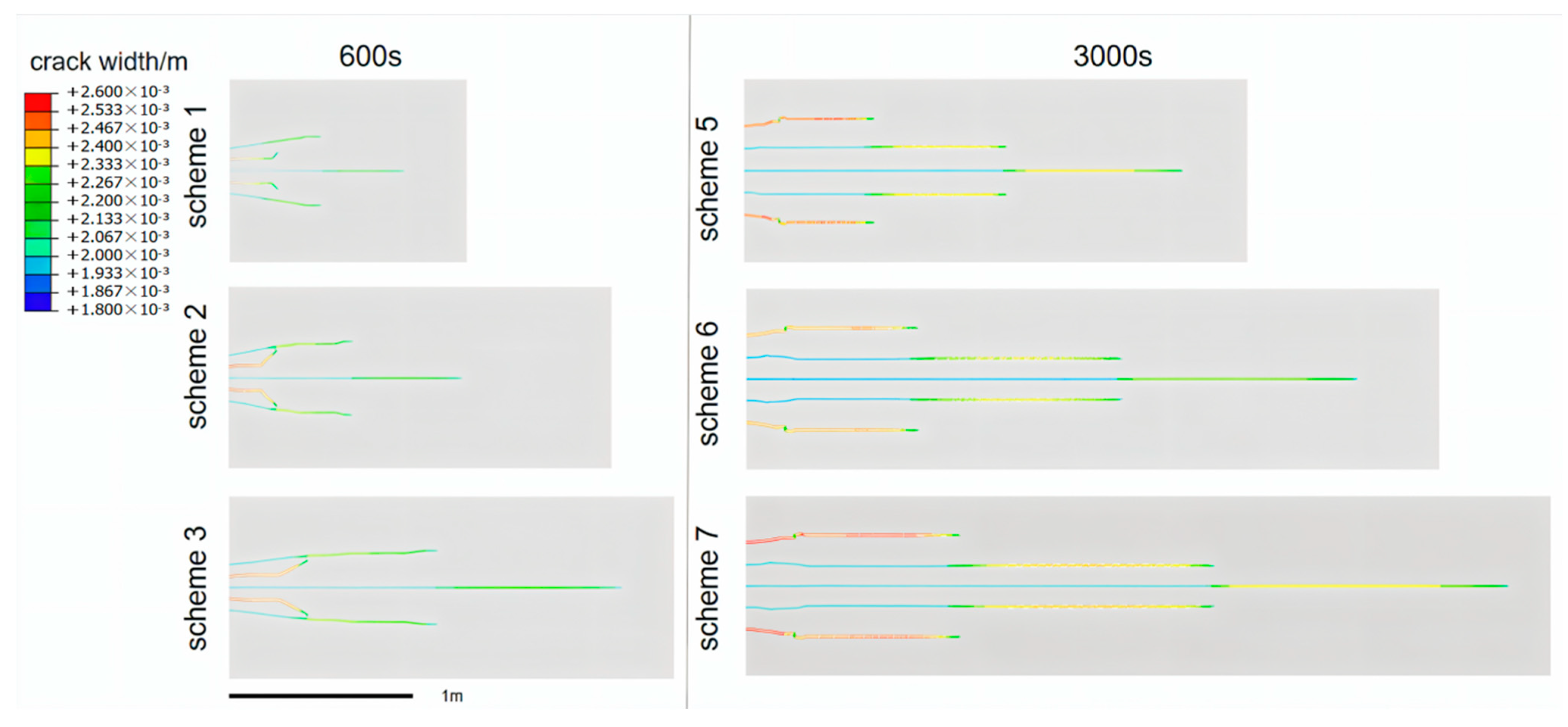


| Sample Number | Axial Pressure /MPa | Confining Pressure /MPa | Injection Flow Rate (mL/min) |
|---|---|---|---|
| S2 | 20 | 15 | 15 |
| S4 | 20 | 15 | 10 |
| S6 | 20 | 15 | 5 |
| S9 | 20 | 20 | 5 |
| S10 | 25 | 15 | 5 |
| S13 | 25 | 20 | 5 |
| S15 | 25 | 15 | 10 |
| Bedding and Horizontal Angle | Elastic Modulus | Poisson’s Ratio | Tensile Strength | Porosity | Permeability |
|---|---|---|---|---|---|
| 0° | 13.3 GPa | 0.147 | 15.40 MPa | 2.12% | 6.92 × 10−4 mD |
| Sample | Initiation Time of Perforation 1/s | Initiation Pressure of Perforation 1/MPa | Initiation Time of Perforation 2/s | Initiation Pressure of Perforation 2/MPa | Average Initiation Pressure/MPa |
|---|---|---|---|---|---|
| S2 | 24 | 44.7 | 55 | 35.3 | 40.0 |
| S4 | 47 | 35.6 | 33 | 28.0 | 31.8 |
| S6 | 81 | 31.3 | 52 | 28.2 | 29.75 |
| Parameter | Numerical Value | Parameter | Numerical Value |
|---|---|---|---|
| Density | 2600 | Porosity | 0.01 |
| Elastic modulus | 30 GPa | Fluid viscosity | 10 mPa·s |
| Poisson’s ratio | 0.22 | Leakoff coefficient | 1 × 10−12 |
| Tensile strength | 2 MPa | Initial crack length | 0.01 m |
| Permeability coefficient | 1 × 10−7 m/s | Pore pressure | 20 MPa |
| Scheme | Number of Perforations | Spacing/cm | Three-Dimensional Stress/MPa | Injection Flow Rate/L/min | ||
|---|---|---|---|---|---|---|
| 1 | 5 | 6 | 25 | 15 | 20 | 1 |
| 2 | 5 | 6 | 25 | 15 | 20 | 5 |
| 3 | 5 | 6 | 25 | 15 | 20 | 10 |
| 4 | 5 | 6 | 20 | 15 | 20 | 5 |
| 5 | 5 | 12 | 25 | 15 | 20 | 1 |
| 6 | 5 | 12 | 25 | 15 | 20 | 5 |
| 7 | 5 | 12 | 25 | 15 | 20 | 10 |
| 8 | 5 | 12 | 20 | 15 | 20 | 5 |
| 9 | 3 | 12 | 25 | 15 | 20 | 1 |
| 10 | 3 | 12 | 25 | 15 | 20 | 5 |
| 11 | 3 | 12 | 25 | 15 | 20 | 10 |
| 12 | 3 | 12 | 20 | 15 | 20 | 5 |
| Parameter | Numerical Value | Parameter | Numerical Value |
|---|---|---|---|
| Pore pressure | 30 MPa | Porosity | 0.05 |
| Elastic modulus | 23 GPa | Fluid viscosity | 0.01 mPa∙s |
| Poisson’s ratio | 0.25 | Injection rate | 1.25 |
Disclaimer/Publisher’s Note: The statements, opinions and data contained in all publications are solely those of the individual author(s) and contributor(s) and not of MDPI and/or the editor(s). MDPI and/or the editor(s) disclaim responsibility for any injury to people or property resulting from any ideas, methods, instructions or products referred to in the content. |
© 2024 by the authors. Licensee MDPI, Basel, Switzerland. This article is an open access article distributed under the terms and conditions of the Creative Commons Attribution (CC BY) license (https://creativecommons.org/licenses/by/4.0/).
Share and Cite
Ding, D.; Xiong, W.; Guo, W.; Yu, H.; Wang, K. A Study on the Mechanism of Fracture Initiation and Propagation under Multi-Perforation Conditions in Hydraulic Fracturing. Processes 2024, 12, 1002. https://doi.org/10.3390/pr12051002
Ding D, Xiong W, Guo W, Yu H, Wang K. A Study on the Mechanism of Fracture Initiation and Propagation under Multi-Perforation Conditions in Hydraulic Fracturing. Processes. 2024; 12(5):1002. https://doi.org/10.3390/pr12051002
Chicago/Turabian StyleDing, Dongwei, Wei Xiong, Wei Guo, Haiqing Yu, and Keyuan Wang. 2024. "A Study on the Mechanism of Fracture Initiation and Propagation under Multi-Perforation Conditions in Hydraulic Fracturing" Processes 12, no. 5: 1002. https://doi.org/10.3390/pr12051002





